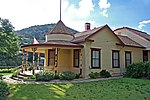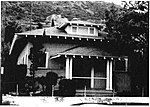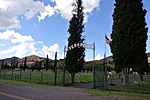Copper Queen Mine
1877 establishments in Arizona TerritoryBuildings and structures in Cochise County, ArizonaCopper mines in ArizonaHistory of ArizonaIndustrial Workers of the World in Arizona ... and 3 more
Mining museums in ArizonaMuseums in Cochise County, ArizonaUnderground mines in the United States

The Copper Queen Mine was a copper mine in Cochise County, Arizona, United States. Its development led to the growth of the surrounding town of Bisbee in the 1880s. Its orebody ran 23% copper, an extraordinarily high grade. It was acquired by Phelps Dodge in 1885. In the early 1900s, this was the most productive copper mine in Arizona. While copper mining declined in the area in the 1930s and 1940s, the Copper Queen continued to be mined by the open-pit process during the years following World War II. With decreasing returns, Phelps Dodge closed it in 1985.
Excerpt from the Wikipedia article Copper Queen Mine (License: CC BY-SA 3.0, Authors, Images).Copper Queen Mine
Main Street,
Geographical coordinates (GPS) Address Nearby Places Show on map
Geographical coordinates (GPS)
| Latitude | Longitude |
|---|---|
| N 31.440655 ° | E -109.914797 ° |
Address
Main Street
Main Street
85603
Arizona, United States
Open on Google Maps











